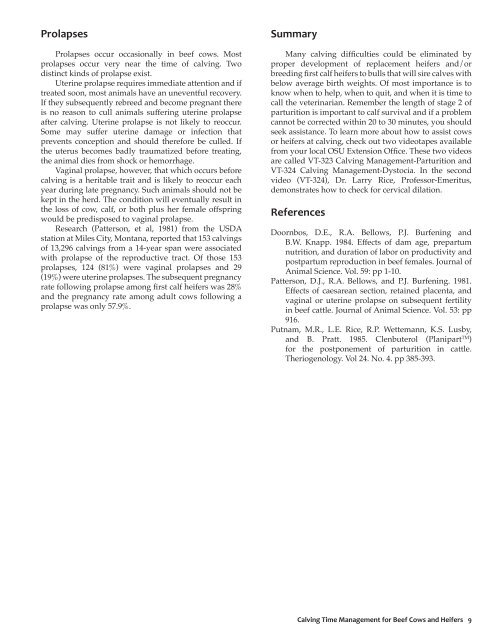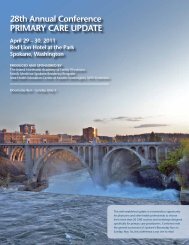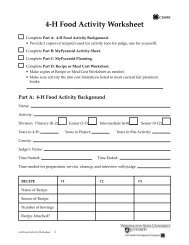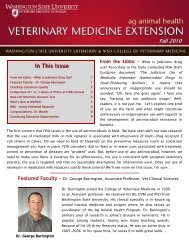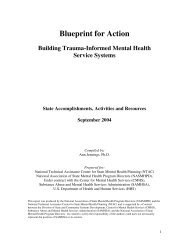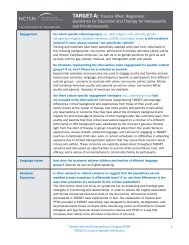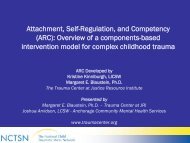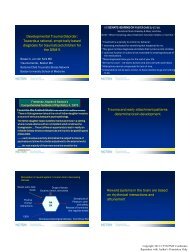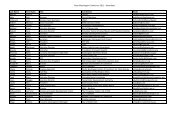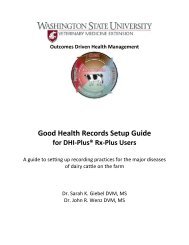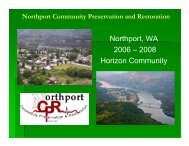Calving Time Management for Beef Cows and ... - OSU Fact Sheets
Calving Time Management for Beef Cows and ... - OSU Fact Sheets
Calving Time Management for Beef Cows and ... - OSU Fact Sheets
- No tags were found...
You also want an ePaper? Increase the reach of your titles
YUMPU automatically turns print PDFs into web optimized ePapers that Google loves.
ProlapsesProlapses occur occasionally in beef cows. Mostprolapses occur very near the time of calving. Twodistinct kinds of prolapse exist.Uterine prolapse requires immediate attention <strong>and</strong> iftreated soon, most animals have an uneventful recovery.If they subsequently rebreed <strong>and</strong> become pregnant thereis no reason to cull animals suffering uterine prolapseafter calving. Uterine prolapse is not likely to reoccur.Some may suffer uterine damage or infection thatprevents conception <strong>and</strong> should there<strong>for</strong>e be culled. Ifthe uterus becomes badly traumatized be<strong>for</strong>e treating,the animal dies from shock or hemorrhage.Vaginal prolapse, however, that which occurs be<strong>for</strong>ecalving is a heritable trait <strong>and</strong> is likely to reoccur eachyear during late pregnancy. Such animals should not bekept in the herd. The condition will eventually result inthe loss of cow, calf, or both plus her female offspringwould be predisposed to vaginal prolapse.Research (Patterson, et al, 1981) from the USDAstation at Miles City, Montana, reported that 153 calvingsof 13,296 calvings from a 14-year span were associatedwith prolapse of the reproductive tract. Of those 153prolapses, 124 (81%) were vaginal prolapses <strong>and</strong> 29(19%) were uterine prolapses. The subsequent pregnancyrate following prolapse among first calf heifers was 28%<strong>and</strong> the pregnancy rate among adult cows following aprolapse was only 57.9%.SummaryMany calving difficulties could be eliminated byproper development of replacement heifers <strong>and</strong>/orbreeding first calf heifers to bulls that will sire calves withbelow average birth weights. Of most importance is toknow when to help, when to quit, <strong>and</strong> when it is time tocall the veterinarian. Remember the length of stage 2 ofparturition is important to calf survival <strong>and</strong> if a problemcannot be corrected within 20 to 30 minutes, you shouldseek assistance. To learn more about how to assist cowsor heifers at calving, check out two videotapes availablefrom your local <strong>OSU</strong> Extension Office. These two videosare called VT-323 <strong>Calving</strong> <strong>Management</strong>-Parturition <strong>and</strong>VT-324 <strong>Calving</strong> <strong>Management</strong>-Dystocia. In the secondvideo (VT-324), Dr. Larry Rice, Professor-Emeritus,demonstrates how to check <strong>for</strong> cervical dilation.ReferencesDoornbos, D.E., R.A. Bellows, P.J. Burfening <strong>and</strong>B.W. Knapp. 1984. Effects of dam age, prepartumnutrition, <strong>and</strong> duration of labor on productivity <strong>and</strong>postpartum reproduction in beef females. Journal ofAnimal Science. Vol. 59: pp 1-10.Patterson, D.J., R.A. Bellows, <strong>and</strong> P.J. Burfening. 1981.Effects of caesarean section, retained placenta, <strong>and</strong>vaginal or uterine prolapse on subsequent fertilityin beef cattle. Journal of Animal Science. Vol. 53: pp916.Putnam, M.R., L.E. Rice, R.P. Wettemann, K.S. Lusby,<strong>and</strong> B. Pratt. 1985. Clenbuterol (Planipart TM )<strong>for</strong> the postponement of parturition in cattle.Theriogenology. Vol 24. No. 4. pp 385-393.<strong>Calving</strong> <strong>Time</strong> <strong>Management</strong> <strong>for</strong> <strong>Beef</strong> <strong>Cows</strong> <strong>and</strong> Heifers 9


